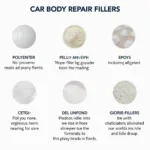Dealing with car scratches can be a real pain. Whether it’s a minor scuff from a shopping cart or a deeper scrape from an unfortunate encounter with a rogue branch, car body scratches can be unsightly and impact the overall look of your vehicle. While serious scratches often require professional car body shop repair, you might be surprised to learn that you can fix minor to moderate scratches yourself using DIY methods. This comprehensive guide will walk you through everything you need to know about car body scratch repair diy, from assessing the damage to achieving a professional-looking finish.
Understanding Car Scratch Types and Severity
Before you grab your tools and cleaning supplies, it’s crucial to understand the type and severity of the scratch you’re dealing with. This assessment will determine the best course of action for repair.
1. Clearcoat Scratches: These are the most superficial scratches, only affecting the outermost layer of your car’s paint, known as the clearcoat. They often appear white or lighter than your car’s paint color.
2. Paint Scratches: Deeper than clearcoat scratches, these penetrate the color layer of your car’s paint. You’ll be able to see the underlying primer or bare metal depending on the depth.
3. Deep Scratches: These scratches go beyond the paint, reaching the metal body of your car. Deep scratches require more involved repair methods and might be best handled by professionals, especially if rust has begun to form.
DIY Car Scratch Repair: Step-by-Step Guide
For this guide, we’ll focus on repairing minor to moderate clearcoat and paint scratches that haven’t reached the metal.
1. Clean the Area: Thoroughly wash the scratched area with car wash soap and water to remove dirt, grime, and debris. Use a microfiber cloth to avoid further scratching.
2. Assess the Damage: Once clean, examine the scratch under good lighting to determine its depth and type. If you can’t feel the scratch with your fingernail, it’s likely a clearcoat scratch.
3. Sanding (If Necessary): For deeper paint scratches, you’ll need to sand down the area. Start with a fine-grit sandpaper (2000-grit) and gradually work your way up to a finer grit (3000-grit). Use gentle, even strokes, and keep the sandpaper wet to avoid further damage.
4. Apply Rubbing Compound: Using a clean microfiber cloth, apply a small amount of rubbing compound to the scratched area. Rub in circular motions, applying moderate pressure. This step helps to remove any remaining scratches and imperfections.
5. Buff with Polishing Compound: After the rubbing compound, use a polishing compound to restore shine and gloss to the affected area. Apply and buff in the same way as the rubbing compound.
6. Wax and Protect: Once you’re satisfied with the finish, protect your hard work by applying a layer of car wax. This will help to seal the paint and prevent future damage.
When to Call in the Professionals
While DIY car scratch repair can be effective for minor to moderate scratches, some situations warrant professional attention. If you’re dealing with:
- Deep scratches that expose bare metal
- Rust formation around the scratch
- Scratches on delicate areas like bumpers or plastic trim
- Extensive scratch damage
…it’s best to consult a professional car body shop repair Stevenage to ensure proper repair and avoid further damage. Deciding between car body repair home repair or shop depends on the extent of the damage and your comfort level with car repair.
Tips for Successful DIY Car Scratch Repair
- Patience is Key: Don’t rush the process. Take your time with each step to achieve the best results.
- Work in a Shaded Area: Avoid direct sunlight while working, as it can cause the rubbing and polishing compounds to dry too quickly.
- Use High-Quality Products: Invest in reputable car care products specifically designed for scratch repair.
- Less is More: When applying compounds or wax, start with a small amount and add more if needed.
Conclusion
DIY car body scratch repair can be a rewarding and cost-effective way to maintain your car’s appearance. By understanding the type of scratch, following the right steps, and using the appropriate products, you can achieve impressive results and restore your car’s finish to its former glory. However, it’s important to recognize when a professional touch is needed. If you’re unsure about tackling a car scratch yourself, don’t hesitate to seek expert help.



